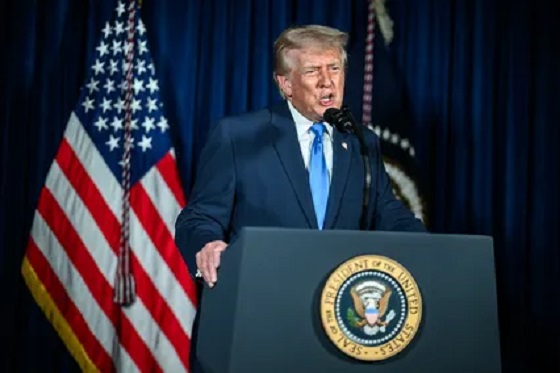Economy
Ottawa should abandon unfeasible and damaging ‘net-zero’ plan

From the Fraser Institute
A high-power AI chip uses as much electricity per year as three electric vehicles (and by the way, one EV per household would double residential electricity demand)
According to the Trudeau government’s plan, Canada will reduce greenhouse gas emissions to “net-zero” by 2050, largely by “phasing out unabated fossil fuels.” But given current technologies, virtually all fossil fuels are “unabated”—that is, they generate greenhouse gases when burned. So basically, the plan is to phase-out fossil fuel use, use wind and solar power to power our lives, and transition to electric vehicles.
But this plan is simply not feasible.
In a recent study, Vaclav Smil, professor emeritus at the University of Manitoba, spotlights some uncomfortable realities. Since the Kyoto Protocol was enacted in 1997, essentially setting the world on the path to net-zero, global fossil fuel consumption has surged by 55 per cent. And the share of fossil fuels in global energy consumption has barely decreased from 86 per cent to 82 per cent. In other words, writes Smil, “by 2023, after a quarter century of targeted energy transition, there has been no absolute global decarbonization of energy supply. Just the opposite. In that quarter century, the world has substantially increased its dependence on fossil carbon.” It’s worth noting that Smil is not some “climate denier”—he’s a strong believer in manmade climate change, and sees it as a serious danger to humanity.
In another recent article, Mark Mills, renowned energy policy analyst, boldly declares, “The Energy Transition Won’t Happen,” in part because developments in computing technologies such as cloud computing and artificial intelligence (AI) will require more energy than ever before, “shattering any illusion that we will restrict supplies.” Mills provides some eye-popping examples of how cloud and AI will suck up vast amounts of energy. A high-power AI chip uses as much electricity per year as three electric vehicles (and by the way, one EV per household would double residential electricity demand).
And chip-maker Nvidia, Mills observes, produced some five million such chips in the last three years, and market demand for them is soaring. The appetite for AI chips is “explosive and essentially unlimited.” The data centres that power cloud computing are also mind-boggling in their energy use, each with an energy appetite often greater than skyscrapers the size of the Empire State Building. The largest data centres consume more energy than a steel mill. And the energy used to enable one hour of video (courtesy of all that cloud computing) is more than the share of fuel consumed by a single person on a 10-mile bus ride.
And yet, on the march towards the unreachable goal of net-zero, government policies have forced out coal-power generation in favour of more costly natural-gas power generation, significantly increasing Canadian’s energy costs. Shifting to lower-GHG energy generation has raised the cost of power, particularly in provinces dependent on fossil-fuel power, while the federal carbon tax drives up costs of energy production. And all at a time when significant numbers of Canadians are mired in energy poverty (when households must devote a significant share of their after-tax income to cover the cost of energy used for transportation, home heating and cooking).
No government should base public policy on wishful thinking or make arbitrary commitments to impossible outcomes. This type of policymaking leads to failure. The Trudeau government should abandon the net-zero by 2050 plan and the never-gonna-happen fossil fuel phase-out, and cease its economically damaging energy, tax and industrial policies it has deployed to further that agenda.
Author:
Business
Canada Hits the Brakes on Population

The population drops for the first time in years, exposing an economy built on temporary residents, tuition cash, and government debt rather than real productivity
Canadians have been told for years that population decline was unthinkable, that it was an economic death spiral, that only mass immigration could save us. That was the line. Now the numbers are in, and suddenly the people who said that are very quiet.
Statistics Canada reports that between July 1 and October 1, 2025, Canada’s population fell by 76,068 people, a decline of 0.2 percent, bringing the total population to 41,575,585. This is not a rounding error. It is not a model projection. It is an official quarterly population loss, outside the COVID period, confirmed by the federal government’s own data
The reason matters. This did not happen because Canadians suddenly stopped having children or because of a natural disaster. It happened because the number of non‑permanent residents dropped by 176,479 people in a single quarter, the largest quarterly decline since comparable records began in 1971. Permit expirations outpaced new permits by more than two to one. Outflows totaled 339,505, while inflows were just 163,026
That is the so‑called growth engine shutting down.
Permanent immigration continued at roughly the same pace as before. Canada admitted 102,867 permanent immigrants in the quarter, consistent with recent levels. Births minus deaths added another 17,600 people. None of that was enough to offset the collapse in temporary residency. Net international migration overall was negative, at minus 93,668
And here’s the part you’re not supposed to say out loud. For the Liberal‑NDP government, this is bad news. Their entire economic story has rested on population‑driven GDP growth, not productivity. Add more people, claim the economy is growing, borrow more money, and run the national credit card a little harder. When population growth reverses, that illusion collapses. GDP per capita does not magically improve. Housing shortages do not disappear. The math just stops working.
The regional numbers make that clear. Ontario’s population fell by 0.4 percent in the quarter. British Columbia fell by 0.3 percent. Every province and territory lost population except Alberta and Nunavut, and even Alberta’s growth was just 0.2 percent, its weakest since the border‑closure period of 2021
Now watch who starts complaining first. Universities are already bracing for it. Study permit holders alone fell by 73,682 people in three months, with Ontario losing 47,511 and British Columbia losing 14,291. These are the provinces with the largest university systems and the highest dependence on international tuition revenue
You’re going to hear administrators and activists say this is a crisis. What they mean is that fewer students are paying international tuition to subsidize bloated campuses and programs that produce no measurable economic value. When the pool of non‑permanent residents shrinks, departments that exist purely because enrollment was artificially inflated start to disappear. That’s not mysterious. That’s arithmetic.
For years, Canadians were told that any slowdown in population growth was dangerous. The truth is more uncomfortable. What’s dangerous is building a national economic model on temporary residents, borrowed money, and headline GDP numbers while productivity stagnates. The latest StatsCan release doesn’t just show a population decline. It shows how fragile the story really was, and how quickly it unravels when the numbers stop being padded.
Subscribe to The Opposition with Dan Knight
Business
White House declares inflation era OVER after shock report

The White House on Thursday declared a decisive turn in the inflation fight, pointing to new data showing core inflation has fallen to its lowest level in nearly five years — a milestone the administration says validates President Donald Trump’s economic reset after inheriting what it calls a historic cost-of-living crisis from the Biden era. In a statement accompanying the report, White House Press Secretary Karoline Leavitt said inflation “came in far lower than market expectations,” drawing a sharp contrast with the 9 percent peak under President Joe Biden and arguing the numbers reflect sustained relief for American households. “Core inflation is at a new multi-year low, as prices for groceries, medicine, gas, airfare, car rentals, and hotels keep falling,” Leavitt said, adding that lower prices and rising paychecks are expected to continue into the new year.
According to the White House, core inflation — widely viewed by economists as the most reliable gauge because it strips out volatile food and energy costs — is now down roughly 70 percent from its Biden-era high. Officials noted that if inflation continues at the pace of the last two months, it would be running at an annualized rate of about 1.2 percent, well below the Federal Reserve’s 2 percent target. The report also highlighted broad-based price moderation across consumer staples and services, with declines in groceries, dairy, fruits and vegetables, prescription drugs, clothing, airfares, natural gas, car and truck rentals, and hotel prices. Average gas prices have fallen to multi-year lows, while rent inflation has dropped to its lowest level since October 2021, a shift the administration attributes in part to tougher enforcement against illegal immigration and reduced pressure on housing demand.
Wages, the White House says, are rising alongside easing prices. Private-sector workers are on track to see real wages increase by about $1,300 in President Trump’s first full year back in office, clawing back purchasing power lost during the inflation surge of the previous administration. Gains are strongest among blue-collar workers, with annualized real earnings up roughly $1,800 for construction workers and $1,600 for manufacturing employees. Administration officials also took aim at critics who warned Trump’s tariff policies would reignite inflation, arguing the data shows no demonstrable inflationary impact despite repeated predictions from Wall Street and academic economists.
NEC Director Kevin Hassett on the latest inflation report: "It was just an absolute blockbuster report… We looked at 61 forecasts, and this number came in better than every single one of them." 🔥 pic.twitter.com/rBJpkmjuNa
— Rapid Response 47 (@RapidResponse47) December 18, 2025
Even commentators across the media spectrum acknowledged the strength of the report. CNBC’s Steve Liesman called it “a very good number,” while CNN’s Matt Egan said it was “another step in the right direction.” Harvard economist Ken Rogoff described the reading as “a better number than anyone was expecting,” adding, “There’s no other way to spin it.” Bloomberg’s Chris Anstey noted the figure came in two-tenths below the lowest estimate in a survey of 62 economists, calling it “remarkable,” while The Washington Post’s Andrew Ackerman wrote that inflation “cooled unexpectedly,” easing pressure on household budgets.
For the White House, the message was blunt: the inflation era is over. Officials framed Thursday’s report as proof that Trump has followed through on his promise to defeat the cost-of-living crisis he inherited, laying what they called the groundwork for a strong year ahead. As the president told the nation this week, the administration insists the progress is real — and that, in his words, the best is yet to come.
-

 International2 days ago
International2 days agoBondi Beach Shows Why Self-Defense Is a Vital Right
-

 Business2 days ago
Business2 days agoOttawa Pretends To Pivot But Keeps Spending Like Trudeau
-

 Energy2 days ago
Energy2 days agoLiberals Twisted Themselves Into Pretzels Over Their Own Pipeline MOU
-

 Censorship Industrial Complex2 days ago
Censorship Industrial Complex2 days agoHow Wikipedia Got Captured: Leftist Editors & Foreign Influence On Internet’s Biggest Source of Info
-

 Crime1 day ago
Crime1 day agoBondi Beach Survivor Says Cops Prevented Her From Fighting Back Against Terrorists
-

 Automotive1 day ago
Automotive1 day agoFord’s EV Fiasco Fallout Hits Hard
-

 Crime1 day ago
Crime1 day agoThe Uncomfortable Demographics of Islamist Bloodshed—and Why “Islamophobia” Deflection Increases the Threat
-

 Frontier Centre for Public Policy16 hours ago
Frontier Centre for Public Policy16 hours agoCanada Lets Child-Porn Offenders Off Easy While Targeting Bible Believers









